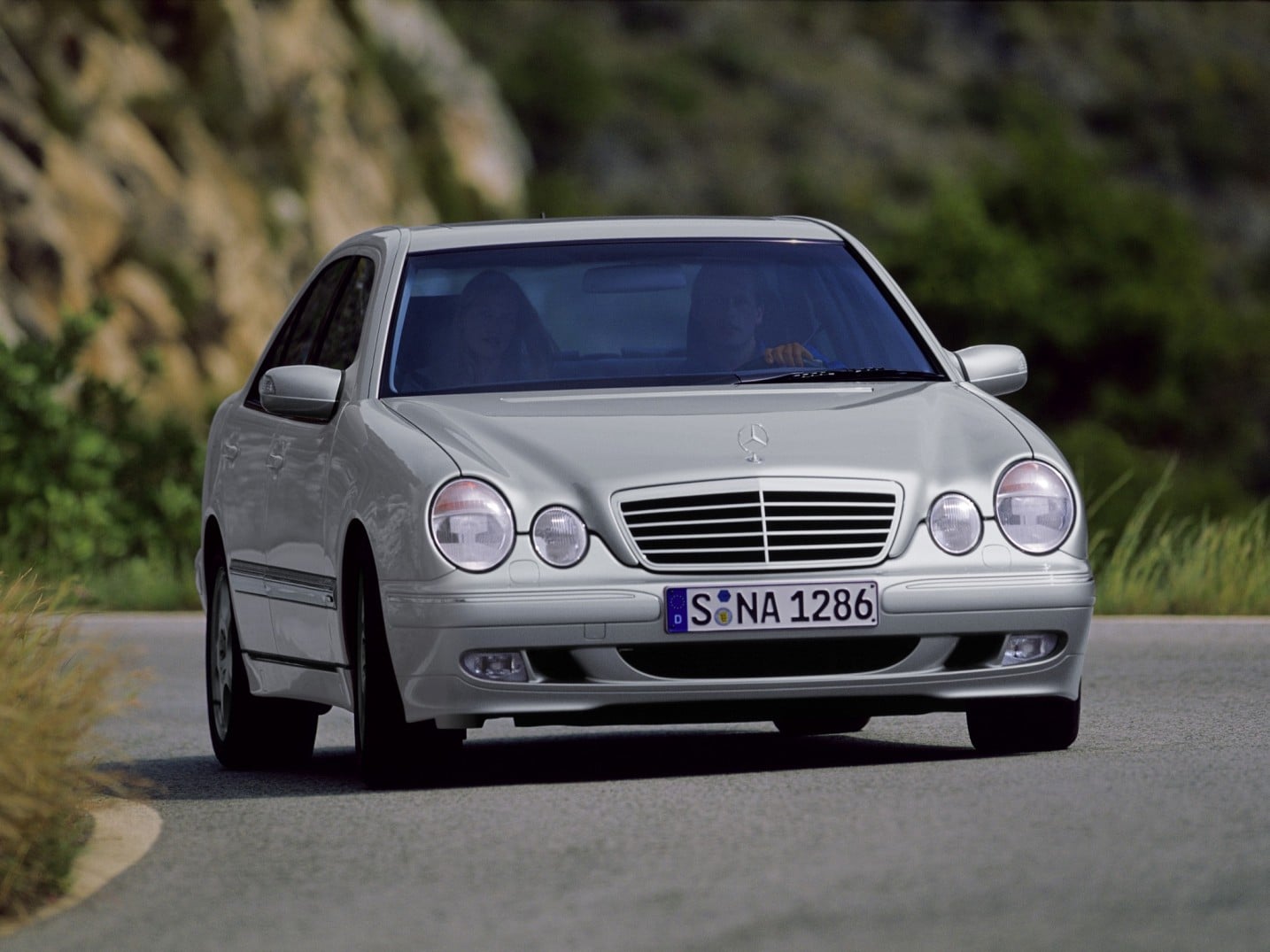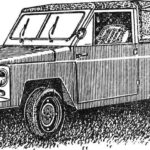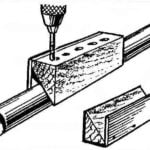 In automotive publications many legends about the origin of the name MERCEDES and the famous three-rayed star, crowning the radiators of the cars of this brand. However, most historians of technology agree that the three-rayed star symbolizes the Union of the three founders of Daimler-Motoren-Gesellschaft, the designers Gottlieb Daimler, Wilhelm Maybach and the businessman Emil Elinika. And the name MERCEDES was awarded in 1901 the first truly successful car company, appeared at the insistence of Lineka, whose daughter was named Mercedes.
In automotive publications many legends about the origin of the name MERCEDES and the famous three-rayed star, crowning the radiators of the cars of this brand. However, most historians of technology agree that the three-rayed star symbolizes the Union of the three founders of Daimler-Motoren-Gesellschaft, the designers Gottlieb Daimler, Wilhelm Maybach and the businessman Emil Elinika. And the name MERCEDES was awarded in 1901 the first truly successful car company, appeared at the insistence of Lineka, whose daughter was named Mercedes.
MERCEDES 35PS had a classic layout with front steering and rear driving wheels and a four-cylinder 5.9-liter engine at the front. The design of the machine has been so successful that it formed the basis of a number of subsequent models produced under the brand name MERCEDES-SIMPLEX, among them such well-known enough machines with indexes 40/45PS and 60PS. Incidentally, the latter with a 60-horsepower engine cylinder capacity cm3 9235 belonged to the class of racing. Established in 1903, she won the first victory in the competition near nice.
In the period preceding the First world war, Daimler-Motoren-Gesellschaft produced a number of cars, including luxury limousines with fully closed bodies, as well as some racing, won a lot of victories in numerous races.
The first world war changed the nomenclature of production — in the production program of the company appeared military trucks and staff cars. However, in 1921, Daimler began a series of experiments with the engine of the new MERCEDES 28/95PS, equipping it with a volumetric supercharger compressor, which allowed the half to increase the power of the motor. In 1923, this work culminated in the release is known among historians autostructure series MERCEDES 24/100/140PS, continued the now famous Ferdinand Porsche. This series has been a solid machine for the first time the compressor is equipped with a six-cylinder engine working volume of 6.24 l turbo 100-140 HP, with a block of light alloy.

MERCEDES SIMPLEX 60PS (1903)

MERCEDES-BENZ SS (1929)

MERCEDES 24/100/140PS design by F. a Porsche (1924)

Executive MERCEDES-BENZ 540K inline 8-cylinder compressor 180 HP engine (1937)

Sports car MERCEDES-BENZ 300SL with a body made of aluminum alloy inline 6-cylinder engine 215лі.with. (1954)

The European car of the upper middle class of MERCEDES-BENZ E-class release 1996

MERCEDES-BENZ E-class release 2002
In 1926 there was a significant in the world of automotive history event: Daimler-Motoren-Gesellschaft and Benz merged to form Daimler-Benz and, respectively, a new automotive brand MERCEDES-BENZ.
By combining the experience and knowledge of designers of both companies, headed by rose F. Porsche, the new concern could quite effectively to organize the work, having developed a series of machines, one of which is a model with a six-cylinder compressor engine, develops a speed of up to 145 km/h that became the basis for a very popular at the time the car series S.
In 1928 the place of departed from group F. Porsche took Hans Nibel, who headed work on the production of cars MANNHEIM 370 and NURBURG 500, base which served as the latest models F. Porsche.
The management of Daimler-Benz in the quest to find new buyers of their products along with huge cars organized the production of cheaper small cars. So, in 1930, the group released the MERCEDES-BENZ 770 with a 200-strong 7,655-liter eight-cylinder engine with supercharger and almost simultaneously — compact with a six-cylinder MERCEDES 170 1,692-liter engine and independent suspension of the front wheels.
Similarly, along with the most famous car at that time MERCEDES-BENZ 540K issue, 1934, is equipped with a 5.4-liter compressor engine capacity of 115 HP (supercharged— 180 HP) and could develop a top speed up to 170 km/h, produced a small MERCEDES 130 with a four-cylinder 1.3-liter 26-horsepower engine.
In 1935, the chief designer of the company is, Nibela appointed max Saller. Under his leadership, was prepared to release a cheap small car MERCEDES 170V, the world’s first serial car with a diesel engine of the MERCEDES 260D, and an updated Executive MERCEDES-BENZ 770, which became very popular with Third Reich leaders.
The outbreak of the Second world war led the company to significantly reduce the release of the “civilian” cars in favor of army trucks and cars. At the end of the war, the enterprises of the concern had been destroyed and automotive manufacturing the factories of Daimler-Benz began to build again only in 1946. Has resumed production of the pre-war MERCEDES 170V sedan with a 38-horsepower engine, followed by a more economical version of this car with a diesel engine.
The first new postwar design firms — became very popular with buyers MERCEDES-BENZ 180 with a monocoque body W120 modern — at the time, these were called pontoon the Machine, presented to journalists by the Chairman of the Board of Directors of Daimler-Benz by Fritz – September 8, 1955, became the firstborn of a group of mid-size vehicles, received in 1993, marking the MERCEDES E-class.
At first, the “180th” were issued only with a 1.8-liter, 52-horsepower row “four”, but in 1955 came the diesel 40-horsepower version of this car — MERCEDES 180D, which became very popular among European taxi drivers. In 1956 there was a more powerful car with petrol 75 HP engine — MERCEDES 190, and two years later in the production run variant of this machine with a 50-horsepower diesel engine
MERCEDES 180 was one of the first cars in the world, a design which had a special sub-frame on which was mounted the engine and components double-wishbone front suspension. Up to 1962 were produced 450 thousand vehicles of this type, which accounted for over 60 per cent of the total output of the group.
New MERCEDES-BENZ 190 with the back of W110 was equipped with row “four” with the capacity of 90 HP, allowing the car to accelerate to a speed of 150 km/h for the First time this car introduced to the public at the Frankfurt motor show in 1961. In the same year appeared the diesel variant of the car — MERCEDES-BENZ 190Dc.
Since 1962, model “190” were equipped with four-speed automatic transmission, rear disc brakes and brake system with two independent circuits. And in 1965, received a new 2-liter petrol and diesel engines, they were manufactured under the name MERCEDES-BENZ 200 and, accordingly, MERCEDES-BENZ 200D. Cars with more powerful inline “six” power 105 HP has received name MERCEDES-BENZ 230. All in all, until 1968, the Daimler-Benz produced 622,2 thousand cars with bodywork W110.
Premiere of the new car with a body W114/W115 was held in January 1968. Unlike previous models, in the notation of these machines featured figure 8, for example, MERCEDES-BENZ 200/8. In this W114 was produced with a four cylinder, a W115 — with six-cylinder engines. In 1974, for machines were Developed the world’s first inline five-cylinder diesel with 80 HP Total until December 1976, produced 1.2 million body W114 and W115.

MERCEDES-BENZ E-class release 2002
Security car:
1 — front impact sensors; 2 — frontal airbag for the front passenger; 3 — control unit with rollover sensor; 4 — system for determining the mass of passengers and recognition of presence on the seat of the child; 5 — the side impact sensors; 6 — side airbags mounted in the backrests of the front seats; 7— pre-tensioners front seat belts with adaptive limiters of maximal effort; 8 — upper side airbags; 9 — side airbag mounted under the upholstery of the rear door; 10 — pre-tensioners rear seat belts with limiters of maximal tension; 11 — frontal driver airbag

Front (A) rear (B) suspension cars

The interior of the front of the cabin
Hitting the market in 1976, the new MERCEDES-BENZ E-class W123 body was 45 mm longer and 16 mm wider than the previous model. The machine can be equipped with any of nine different engines: four of them were diesel and five petrol. Headlights, this model was combined with glass domes. To increase passive vehicle safety the design excludes the front subframe and fuel tank installed above the rear axle closer to the center of the machine, which reduced the likelihood of tank rupture in case of accidents. Just released 2.4 million cars of the W123.
The following MERCEDES-BENZ E-class W124 body was presented to journalists at the end of 1984. The new car was equipped with automatic differential lock (ASD), anti-slip (ASR) and that was the first serial car of company, all-wheel drive with automatic torque distribution (4 Matic). Increased interest of journalists was caused by unusual single wiper. In the future these machines was equipped with anti-lock brake system ABS and airbags, as well as new engines with full electronic control systems and power plugs.
In 1993, the leadership of Daimler-Benz decided to call a car of this size cars E-class, in accordance with the European classification E. All were produced 2.2 million “Mercedes” with a body W124 — 40 percent of all released cars.
The launch of the latest MERCEDES-BENZ E-class W210 with a body, immediately betrothed journalists “big-eyed”, was held on 23 June 1995. The new car incorporates almost all the new autostructure, known at that time: it had a rain sensor, a pollution sensor outside air to facilitate Parking system Parktronic. adaptive five-speed automatic transmission with electronic control and more. In 1997, “big-eyed” new engines — V-shaped “six”, which was 25 percent lighter than the previous one, and then the engines are new generation power supply system Common rail.
The production of cars the W210 was discontinued in November 2001. In total there were produced about 1.4 million copies
And so, in January 2002 from the conveyor of the group went with a new MERCEDES-BENZ E-class — car W211. At first glance, this machine differs little from the previous model, all the same lights-eyes turned, however, from round to oval, all the same respectability, elegance and indomitable streamlined shape… But apparently not very noticeable the changes are obvious: new car 12 mm higher and wider than the previous 23 mm, and the wheelbase has increased by 21 mm. besides, it has a gentle slope of a radiator lattice and separate the glazing from all four headlights.
The perfection of form is directly dependent on its aerodynamic excellence: the drag coefficient of the body W211 is only 0,26— fantastic low result for machines of this class!
If desired, the customer can order a car with a panoramic roof made of greenish glass that transmits into the cabin, only 18 percent of visible light and practically fully absorbing ultraviolet radiation using automatic shutters the roof can be covered completely opaque. Conversely, two large hatches make it possible to enjoy the air and sun. By the way, the machine is equipped with a Tunnel closing, which independently closes the side Windows and hatches at the entrance to the tunnel.
The machine comes in three basic versions: classic, Elegance and Avantgarde, and the body can be painted in any of fifteen colors. However, the appearance of the car though is one of its main consumer qualities, but on clothes, as you know, only meet. Curious, how does it go with “mind”?
We start of course, with the power unit. New cars class E are provided until five: three petrol (Е240, E320 and E500) and two diesel (E220 CDI and CDI Е270). In the future we plan to release four-cylinder petrol engine with mechanical supercharger for E220 Kompressor, E200 CDI turbodiesel for a diesel V-shaped “eight”. Note that four-cylinder diesel E220 CDI provided to balancer shafts to reduce vibrations from the NIC of inertia of the second order. The same devices will be equipped with diesel engines and for E200 CDI.

Now a little about suspension. Although fundamentally it has not changed compared to the predecessor, but improvements several improvements in its parameters. So, was redesigned double-wishbone front hub — lower arm now consists of two separate parts, which favorably affected the kinematics of this node. Upgraded rear suspension — five-link, which first appeared in 1983 on the car with the index “190”, on the new machine it is almost entirely made of aluminum alloy, making it 30 percent lighter. Elastic elements — spring, however, all versions of the new MERCEDES-BENZ E-class can be equipped with active air suspension Airmatic DC, capable, depending on traffic conditions in just 0.005 seconds at a time to change the stiffness of the elastic elements and damping qualities of the shock absorbers. This gives you the opportunity not only to change the ground clearance, but also to neutralize the pecks and rolls under acceleration, braking and cornering. Also in “sport” mode the suspension becomes more rigid, and in “comfort” mode, consequently, softer.
Steering — rack and pinion, adaptive (variable gear ratios), which makes the wheel “sharper” with increasing angle of the front wheels. The steering column can be adjusted both in height and length. On some versions of the steering — variable reactive force on the steering wheel. The adaptive cruise control will keep the distance to the vehicle ahead.
Braking system — electro-hydraulic, type SBC (Sensotronic Brake Control), with disc front and rear brakes, with a more loaded front and rear the SBC System, which has a brake pedal connected to the brake master cylinder are not mechanically, but electrically, allows you to create on each of the wheels is the braking force needed for a specific speed and for a given track condition. Failure to skid in a hard turn is virtually eliminated, even during emergency braking. The whole system works in concert with ABS and ESP, and in the rain the SBC sends the command to the brake pads by short duration pulses, allowing to dry their work surface.
Experts say that the passive safety of the vehicle satisfies the conditions of EuroNCAP. Thanks to the optimal position of the shock sensors automation recognizes the severity of the accident at an earlier stage. Depending on this different will work load limiter which comes into effect after deployment, pretensioner seat belt, almost instantly winding the coil up to 130 mm free part of the belt. And, of course, the machine is equipped with front and side airbags and inflatable curtain Windowbags, which control and intelligent sensors depending on the strength and direction of impact they can make this system work in different modes. And again. MERCEDES-BENZ E-class is the only sedan in the world, equipped with a sensor, signaling the beginning of a rollover, comprising the protective system. According to specialists of the concern — the safety cage, which is enclosed interior of the car is designed for all levels of accidents and saves vital space for passengers even in collisions at high speed and regardless of direction of impact.
Not to mention about the new world automotive industry is the adaptive seats. I press the button on the remote control of the chair and at the slightest change of machine’s position in space, it changes its shape to provide the driver the best possible support. The fact that under the upholstery of the front seats in different zones, there are air bags, which depending on the angle of the steering wheel speed, lateral or longitudinal acceleration, and finally, shaking, automatically, upon command of the microprocessor increases or decreases the air pressure.
Interior design is a bit different than on the previous version of the MERCEDES-BENZ E-class in Front of the driver — the instrument panel with three elegant dials are in the middle of the large speedometer on the right and left tachometer — analog clock. In the right and left corners of the panel — level gauges for fuel and coolant temperature. The most interesting performance speedometer: its Central part is a circular display, which displays the data of the onboard computer, audio and navigation system.
On the center console is a large information display is surrounded by a keyboard control vehicle systems, including control buttons built-in mobile phone (mobile “mobile phone” is located in the armrest). Above the display — control unit or air conditioning system Termotronic. Below the control buttons heater seats and locks.
Main technical characteristics of the car MERCEDES-BENZ E-class

All modification cars E-class is equipped with a sensor headlights and rain sensor, as well as device control computer and an integrated “mobile phone” directly from the steering wheel.
It should be mentioned that the appearance of the new MERCEDES-BENZ E-class has completed the upgrade of the model range of cars of concern. The process began with exclusive limousine S-class, a given style development lineup. It was followed by a new small sedan, the C-class is a smaller version of the flagship. Today completes the range of updates MERCEDES-BENZ E-class.
And finally — the price. Most “cheap” modification E 240 costs about 30 thousand dollars, and the most expensive with an index of “500” — 90 thousand dollars.
I. EVSTRATOV



